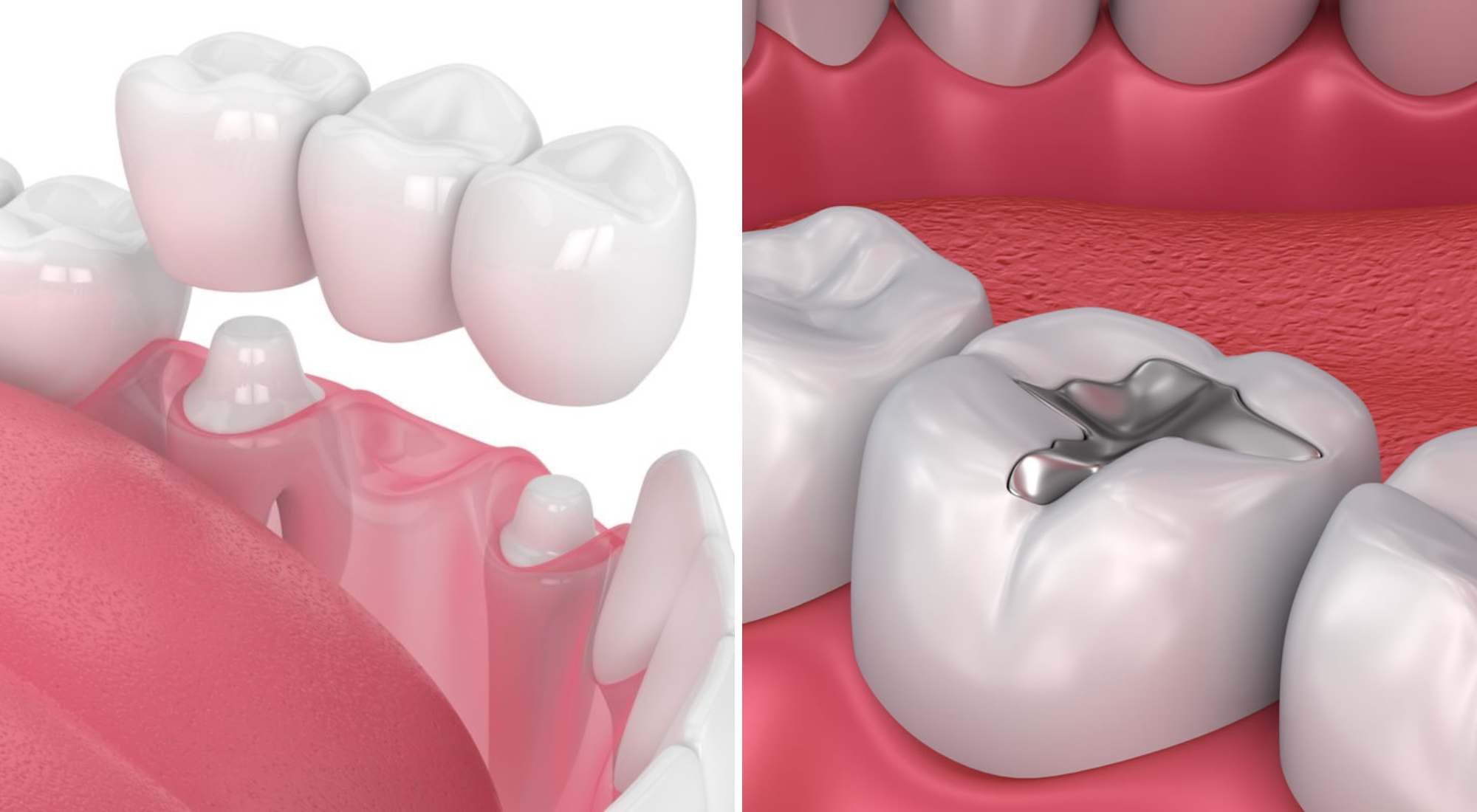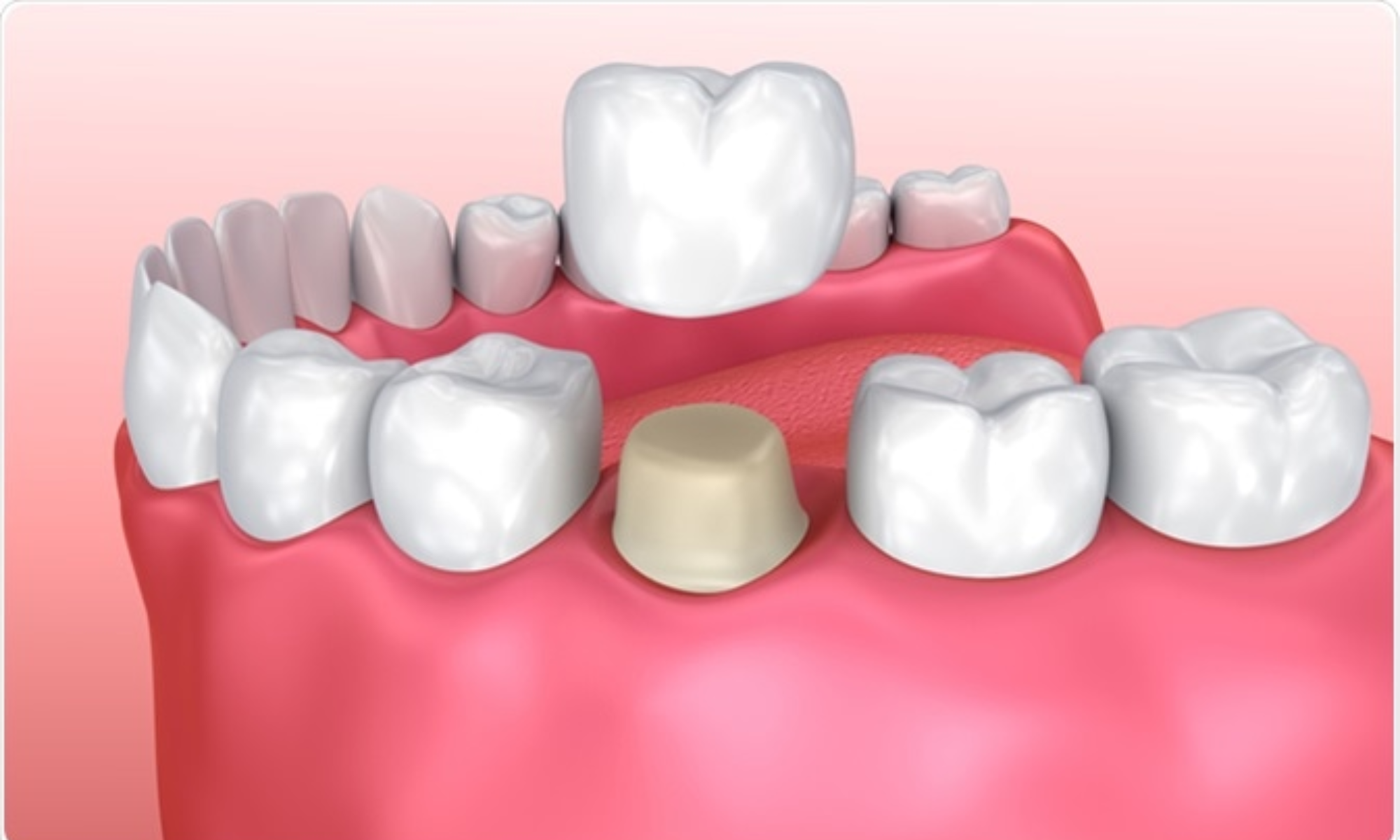We are not a registered Medicare/Medicaid Provider
Crowns vs. Fillings: Choosing the Right Restoration for Your Tooth

Toothaches are no fun. They can be throbbing, dull, or sharp, making it hard to concentrate and enjoy your day. If you’re experiencing a toothache, a trip to the dentist is essential. They can diagnose the cause and recommend the best treatment to restore your healthy smile. Often, the solution involves either a filling or a crown. But how do you know which one you need? Both procedures address tooth problems, but they have distinct purposes. This blog dives into the world of fillings and crowns, explaining their differences. This blog will also help you understand which restoration might be right for your specific situation.
The Mighty Menders: Fillings
Think of fillings as the dental world’s patch-up crew. They’re used to address minor to moderate tooth damage, most commonly caused by cavities. Cavities are tiny holes that form when plaque buildup eats away at your tooth enamel. Here’s when fillings come to the rescue:
- Early-stage cavities: If you catch a cavity early, a filling can stop it from progressing further and prevent the need for more extensive procedures later.
- Minor cracks or chips: Fillings can effectively repair small cracks or chips in your teeth, restoring their functionality and appearance.
- Worn teeth: Over time, teeth can wear down due to grinding or chewing. Fillings can reshape and strengthen worn teeth.
Filling Materials
Dental fillings come in various materials, each with its advantages and disadvantages. Here are the most common ones:
- Composite resin: This tooth-colored material is popular for its aesthetic appeal. It blends seamlessly with the surrounding teeth, making it a great choice for front teeth or visible areas.
- Amalgam (silver fillings): These traditional fillings are known for their durability and affordability. However, their dark color might only be aesthetically pleasing for some.
- Glass ionomer: This filling releases fluoride, which helps strengthen the surrounding tooth structure. It’s often used for children’s teeth.
The Royal Restorations: Crowns
Crowns are like kings and queens in the dental world – they reign supreme when it comes to restoring severely damaged teeth. Unlike fillings that target a specific area, crowns completely encase the entire visible portion of the tooth, offering maximum protection and support. Crowns are recommended for:
- Large cavities: When a cavity is extensive and compromises a significant portion of the tooth structure, a filling might not be strong enough. A crown provides the necessary reinforcement and prevents further damage.
- Cracked or broken teeth: If your tooth has experienced a major crack or fracture, a crown can hold the pieces together and restore its functionality.
- Root canal-treated teeth: After a root canal, the tooth becomes brittle. A crown protects the weakened tooth structure and prevents future breakage.
- Cosmetic enhancements: Crowns can improve the appearance of misshapen or discolored teeth.
Crowning Glory: Materials for Crowns
Crowns are typically made from various materials, each offering unique benefits:
- Porcelain: This popular choice provides a natural-looking, tooth-colored crown that blends beautifully with your smile.
- Metal alloys: These crowns are incredibly strong and durable, making them ideal for back teeth that endure a lot of chewing pressure.
- Porcelain-fused-to-metal (PFM): This combines the aesthetics of porcelain with the strength of metal, offering a good balance between looks and durability.
- Gold: While less common today, gold crowns are known for their exceptional strength and biocompatibility.
The Final Showdown: Fillings vs. Crowns
Round 1: Functionality
– Fillings are best suited for early-stage cavities, minor cracks, or worn tooth surfaces. They preserve the maximum amount of natural tooth structure.
– Crowns are ideal for severely decayed teeth, large cracks or fractures, teeth with significant wear and tear, or those that have undergone root canal procedures. Crowns provide superior strength and protection, allowing the tooth to function normally.
Round 2: Material Matters
– Common materials used for fillings include composite resin (tooth-colored and aesthetically pleasing) and amalgam (metal alloy, durable but less natural-looking).
– Dental crowns are made from various materials like porcelain (highly aesthetic), metal alloys (strong and long-lasting), or a combination of both (offering a balance between aesthetics and strength).
Round 3: Durability
– Dental fillings last for several years with proper care but may need replacement due to wear or chipping.
– On the other hand, crowns are generally more durable than fillings and can last for over a decade or even longer with good oral hygiene practices.
Round 4: Aesthetics
– Composite resin fillings can be matched to the color of your surrounding teeth, offering a natural appearance. Amalgam fillings are quite noticeable due to their dark metal color.
– Crowns are highly customizable! Porcelain crowns can be made to blend in with your smile perfectly.
Round 5: Cost & Procedure
– Dental fillings are less expensive than crowns due to the simpler procedure and less material involved.
– Crowns involve complex procedures requiring multiple appointments. The cost can vary depending on the material and complexity of the crown.
The Winner? It Depends
When it comes to dental restorations, two main contenders emerge: fillings and crowns. But which one reigns supreme for your specific needs? The truth is, there’s no single victor in this battle. Both fillings and crowns play crucial roles in restoring damaged teeth, and the best choice depends entirely on the severity of the damage and your situation. Here’s a detailed breakdown to help you pick the perfect champion for your smile:
The Mighty Filling: Ideal for Minor Repairs and Budget Champions
Champion’s Strength: Fillings excel at fixing minor tooth decay, cracks, and chips. They effectively plug these vulnerabilities, preventing further damage and restoring functionality.
Budget-Friendly: Compared to crowns, fillings are a more cost-effective solution.
Material Matters: Fillings come in various materials, with the most common being composite resin and amalgam. Composite resin fillings offer a natural-looking tooth-colored option, while amalgam fillings boast exceptional durability.
The Crown’s Might: Conquering Extensive Damage and Enhancing Aesthetics
Strength in Numbers: Crowns are the undisputed champions for dealing with extensive tooth damage, cracks, fractures, or severe decay. They completely encase the weakened tooth, providing superior strength and protection.
Double Duty: Beyond structural reinforcement, crowns can also enhance the aesthetics of your smile. Porcelain crowns, for instance, can be crafted to perfectly match the color and shape of surrounding teeth, creating a seamless and natural appearance.
Root Canal Rescue: If a tooth has undergone root canal treatment, a crown is often necessary to safeguard the weakened structure and prevent future fractures.
Having a bright, healthy smile is a desirable goal for many people. But if your teeth are discolored due to old fillings or require structural repair, you might be wondering if teeth whitening is still an option. The answer depends on the type of restoration you have – crowns or fillings. Remember, consulting with a qualified dentist is crucial to determine the best course of action for your specific situation. They can assess your teeth, discuss your cosmetic goals, and recommend the most suitable treatment plan, whether it involves teeth whitening, crowns, fillings, or a combination of procedures.

